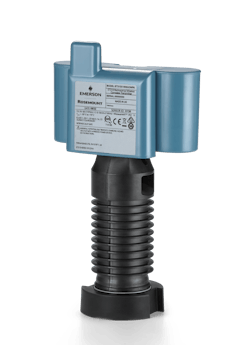How They Made It Work: Emerson’s Rosemount Wireless Permasense ET310C Corrosion Transmitter
"How They Made it Work" is a column that features some of the latest technological advancements in the chemical process industry. Here, Chemical Processing asks experts from various technology providers to provide insight into their innovations and how they're helping chemical manufacturers operate their plants more efficiently and effectively.
Sergio Apuy, global solutions manager with Emerson’s Corrosion and Erosion business unit, explains how accurate pipe wall thickness measurement and corrosion monitoring aid in determining when preventive measures are needed for asset integrity.
Company
Emerson
Technology
The Rosemount Wireless Permasense ET310C Corrosion Transmitter (Figure 1) provides direct measurement of pipe wall thickness, the most accurate indication of asset integrity. The transmitter uses patented signal processing to measure wall thickness and metal loss on any metallurgy, supported by best-in-class material and temperature compensation. Measurement data from the transmitter enables monitoring of corrosion activity to help determine when preventive measures, such as adding inhibitors, are warranted.
Explanation of development, design and purpose
Sulfuric acid and other corrosive fluids are present in many chemical processing plants, including those that produce phenol, nylon or polyurethane. Protecting workers against potential exposure from leaks caused by these and other corrosion mechanisms remains a persistent challenge for these facilities.
Manual solutions require personnel to measure pipe wall thickness using a handheld device, with significant periods between measurements the norm. Each measurement must be made in the exact same location, with differences of a few millimeters problematic. Adding to the difficulty of manual measurements, piping systems may be installed in areas that are hard to access, within high-temperature locations, and/or in areas classified as hazardous.
Significance in chemical plants
Measurements are wirelessly transmitted using the industrial WirelessHART protocol at intervals set by plant personnel, typically once every 12 hours, representing a substantial improvement over monthly — or more — manual measurement frequency. These non-intrusive, intrinsically safe transmitters can be installed without any piping penetrations by simply affixing them to piping with a polymer strap. Once installed, each transmitter is automatically recognized by the network and begins transmitting data to a host system.
Plant personnel can view the measurements provided by the transmitter to gain visibility and insights into the health of critical piping systems. These insights can be used to increase uptime by performing proactive maintenance on corroding piping.
Unique Features
The transmitter uses electromagnetic acoustic transduction, optimized to work even with non-ferritic metals, and transmitters can be installed without interrupting operations. These devices use an electromagnetic field, rather than the mechanical vibration of a piezo transducer, to excite an ultrasonic wave in the pipe or vessel wall. The electromagnetic field between the sensor and the pipe effectively becomes the couplant. This eliminates the need for a gel or physical couplant, extending periods of maintenance-free operation compared to technologies requiring a couplant, as it requires frequent attention.
Emerson’s Plantweb Insight software application provides pipe thickness status and trending, supplying the data needed for proactive maintenance with actionable alerts based on pipe condition.
Success Story
Many plants use sulfuric acid to create caprolactam, one of the precursor materials used in nylon production. The piping system in question was fabricated from carbon steel, so plant personnel had to maintain process conditions within their defined integrity operating window to prevent accelerated corrosion.
There was minimal corrosion for the first few months after the corrosion monitoring system was installed, but accelerated corrosion began shortly thereafter. Plant personnel used this corrosion data to correlate the issue with a change in process parameters, empowering them to take corrective action, mitigate further corrosion and continue production uninterrupted.
About the Author
Sergio Apuy
Global Solutions Manager, Emerson’s Corrosion and Erosion business unit
Sergio Apuy is a global solutions manager with Emerson’s Corrosion and Erosion business unit. He has more than 14 years of experience in the oil & gas and chemical industries, developing solutions for customers to support their measurement and digital transformation initiatives. Apuy holds a BS degree in electronics engineering from Universidad Latina de Costa Rica logo
Universidad Latina de Costa Rica, and he holds a master’s degree in operations and technology from INCAE Business School in Costa Rica.


